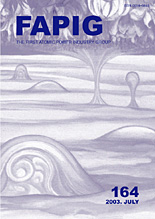![]()
FAPIG
THE FlRST ATOMlC POWER INDUSTRY GROUP
FAPIG誌 最新号目次
2003−7/平成15年度 第1号(No.164)

|
目 次 ■ 報 告 ■ 紹 介 ■ グループ情報 表紙デザイン:佐野 馨 CONTENTS ■ Report ■ Introduction ■ FAPIG Activities Cover Design:Kaoru Sano
SYNOPSES Masahiro Shirakawa, Tomoyuki Murakami, Shigeki Endo, Daiichiro Oguri,
Takeshi Ishikura, Seiji Abe Nuclear Power Engineering Corporation has developed techniques of concrete and metal recycling for decommissioning waste of commercial nuclear power plants. The metal dross is generated from thermal cutting of nuclear reactor structural materials. Some proportion of these dross is classified as ヤrelatively high LLWユ in Japan. To reduce disposal cost, it is studied to dispose it as solidified waste package, not to dispose it as independent disposal waste package, by recycling it as filler material to be filled into gaps of dismantled ヤrelatively high LLWユ metallic materials. Properties of dross generated from thermal cutting of reactor structural materials was investigated and tested for dross size distribution, shape etc. to obtain fundamental data on characteristics of the dross as a mortar filler material. Moreover, investigation and verification test of some processes to package the dross into disposal containers were performed to evaluate possibility of filling processes. KEYWORDS:decommissioning, reactor structure, thermal cutting, metal dross, recycling Hiroshi Ozaki, Akira Takagi, Tetsuji Yoshimura The improvement of speeding up, automatization, simultaneous control
of four axes for conventional Fuel Handling Machines (; FHMs) have been
performed to reduce the fuel handling period. On the other hand, to
achieve these performances leads to the increase of FHM weight, because
more rigidity has been required to improve the positioning accuracy. KEYWORDS:Fuel Handling Machine, FHM, reduction of fuel handling period, speeding up, nuclear power plant, cost reduction, weight reduction Toshimasa Kuroda, Mikio Enoeda, Masato Akiba One of major objectives of ITER is to test blankets to be used in fusion plants to demonstrate power generation. Some horizontal ports in ITER are to be provided for these tests. Parties participating the ITER project and also this test program have developed the design of test blanket modules according to their own blanket concepts for the fusion plants. At the same time, in cooperation with the International Team, the test procedure consistent with the ITER operation schedule, the module structures to be installed into the test port, and the installation of auxiliary systems for testing into the ITER facility have also been investigated. KEYWORDS:ITER, blanket, test program, test blanket module Yoshiaki Takatani, Noriyuki Naito, Takeshi Yoshida, Toru Nagai METI of Japan has been promoting the research and development project, "FOCUS21" since 2002. "FOCUS21" aims to advance industrial competitiveness by assisting research themes, which quickly lead to business. From this background, in February, 2003, NEDO announced the research grant project, "The development of the device by the fusion of Bio and IT / The development of the system and device for the analysis of DNA and protein" . We applied for this project with other five companies, and our theme, "The development of the multiple protein analysis device by the fusion of Bio and IT", was accepted. In this paper, we will describe a tunable mid-infrared solid-state laser for IR-MALDI in this project. KEYWORDS:biotechnology, information technology, protein analysis, tunable laser, mid-infrared laser, solid-state laser, matrix assisted laser desorption/ionization Yasuhiro Sugano The Shibusawa Warehouse Co., Ltd. was certified for ISO9002:1994 as of Mar. 1999 and accomplished its transfer to ISO9001 as of Mar. 2002. This means that our company has maintained ISO9002 and ISO9001 for more than four years. I work as one of the promoting staffs that belong to the management representative. I would like to study the effects and issues occurred by introducing ISO9000s previous four years. Also, I would like to refer to the collaboration with our customers and fellow companies, utilizing ISO19011 and WDI, which I believe to be essential for continual improvement. KEYWORDS:collaboration, ISO9002:1994, ISO9001:2000, ISO19011, WDI Mitsugu Sato, Mituo Yoshikawa Fujitsu group recognizes environmental activities for sustainable development
of the society as an important management issues and executes the activities. KEYWORDS:green products, LCA, fujitsu group environmental policy, green life 21, zero-emission, environmental technologies, solutions, sustainability |
バックナンバー目次
|
号数 |
発行年月 |
| 163 | 2003/ 3 |
| 162 | 2002/11 |
| 161 | 2002/ 7 |
| 160 | 2002/ 3 |
| 159 | 2001/11 |
| 158 | 2001/ 7 |
| 157 | 2001/ 3 |
| 156 | 2000/11 |
| 155 | 2000/ 8 |
| 154 |
2000/
3
|